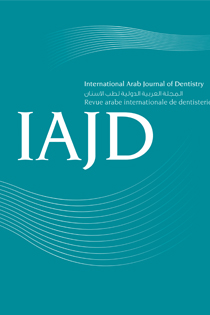Abstract
The role of irrigation in root canal treatment is crucial; sodium hypochlorite is the most commonly used irrigant. Many methods were used to potentiate sodium hypochlorite, one of which is heating of the irrigant. Negative pressure irrigation is a new method of irrigation that was introduced to deliver the solution through the whole root canal length. Sixty single rooted teeth were used in this study. A total of 360 simulated lateral canals were created, 6 in each tooth, with 2 lateral
canals at 2, 4.5 and 6 mm of working length. To resemble the clinical situation, a closed system was created by coating each root with soft modeling wax. Roots were then randomly assigned to 3 experimental groups: group 1 (n = 20): apical negative pressure irrigation (ANP); group 2 (n = 20): apical negative pressure irrigation
with heated irrigant (ANP + Heat); and control group 3 (n = 18): positive pressure irrigation. The samples were evaluated by direct observation of the images recorded by a photography machine. The results showed that ANP and ANP + Heat were more effective than needle irrigation at lateral canal penetration, but there was no significant difference between the groups 1 and 2. Apical negative pressure irrigation is more effective than needle irrigation in penetrating into lateral canals. Heated irrigant did not penetrate better into these canals.

